
A leotard is a unisex skin-tight one-piece garment that covers the torso from the crotch to the shoulder. The garment was made famous by the French acrobatic performer Jules Léotard (1838–1870). There are sleeveless, short-sleeved, and long-sleeved leotards. A variation is the unitard, which also covers the legs. It provides a degree of modesty and style, while allowing for freedom of movement.
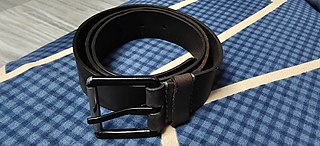
A belt is a flexible band or strap, typically made of leather, plastic, or heavy cloth, worn around the natural waist or near it. The ends of a belt are free; and a buckle forms the belt into a loop by securing one end to another part of the belt, at or near the other end. Often, the resulting loop is smaller than the hips. Belts come in many lengths because of the variety in waist sizes, and most belts can be adjusted at the buckle to suit the wearer's waist.
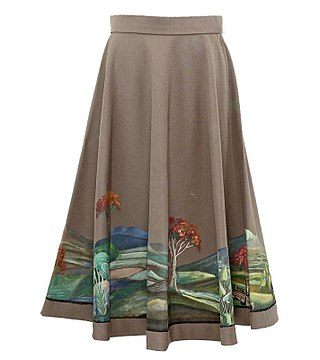
A skirt is the lower part of a dress or a separate outer garment that covers a person from the waist downwards.
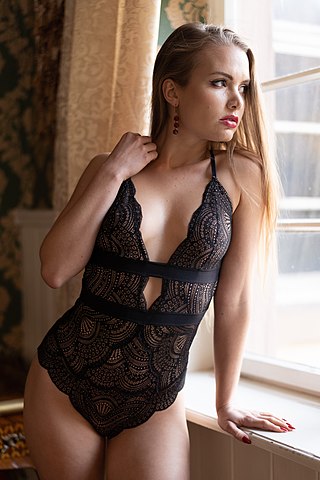
A bodysuit is a one-piece form-fitting or skin-tight garment that covers the torso and the crotch. The of a basic bodysuit is similar to a one-piece swimsuit and a leotard, though the materials may vary. Thong or T-front thong bodysuits usually have the crotch opening moved up to the front to underbelly area to increase the wearer's comfort. A bodysuit may have sleeves and varying shoulder strap and collar. Bodysuits can be made from a number of fabrics, including cotton, lace, nylon, etc. In general, textile bodysuits include expandable fiber such as spandex for a better fit to the shape of the body.
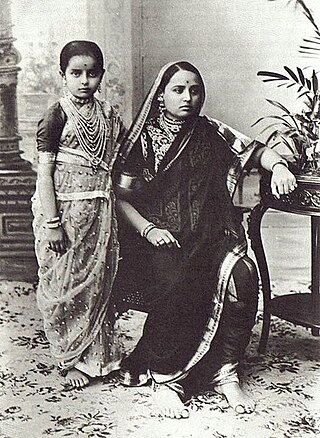
A sari is a women's garment from the Indian subcontinent, that consists of an un-stitched stretch of woven fabric arranged over the body as a robe, with one end attached to the waist, while the other end rests over one shoulder as a stole (shawl), sometimes baring a part of the midriff. It may vary from 4.1 to 8.2 metres in length, and 60 to 120 centimetres in breadth, and is a form of ethnic wear in India, Sri Lanka, Nepal, Bangladesh and Pakistan. There are various names and styles of sari manufacture and draping, the most common being the Nivi style. The sari is worn with a fitted bodice also called a choli and a petticoat called ghagra, parkar, or ul-pavadai. It remains fashionable in the Indian subcontinent today.

Bell-bottoms are a style of trousers that become wider from the knees downward, forming a bell-like shape of the trouser leg.
Clothing in India varies with the different ethnicities, geography, climate, and cultural traditions of the people of each region of India. Historically, clothing has evolved from simple garments like kaupina, langota, achkan, lungi, sari, to rituals and dance performances. In urban areas, western clothing is common and uniformly worn by people of all social levels. India also has a great diversity in terms of weaves, fibers, colors, and the material of clothing. Sometimes, color codes are followed in clothing based on the religion and ritual concerned. The clothing in India also encompasses a wide variety of Indian embroidery, prints, handwork, embellishments, and styles of wearing clothes. A wide mix of Indian traditional clothing and western styles can be seen in India.

A choli is a blouse or a bodice-like upper garment that is commonly cut short leaving the midriff bare, it is worn along with a sari in the Indian subcontinent. The choli is also part of the ghagra choli costume in the Indian subcontinent.

In fashion, the midriff is the human abdomen. The midriff is exposed when wearing a crop top or some forms of swimwear or underwear.

Whale tail is the Y-shaped rear portion of a thong or G-string when visible above the waistline of low-rise pants, shorts, or skirts that resembles a whale's tail. Popularized by a number of female celebrities including Amy Dumas, Christina Aguilera, Victoria Beckham, Mariah Carey, Paris Hilton and Britney Spears, displaying whale tails became popular in the early 2000s, together with the popularity of low-rise jeans and thong panties; but quickly waned within the decade.

Briefs are a type of short, form-fitting underwear and swimwear, as opposed to styles where material extends down the thighs. Briefs have various different styles, usually with a waistband attached to fabric that runs along the pelvis to the crotch and buttocks, and are worn by both men and women. Swim briefs are a variation used as swimwear.
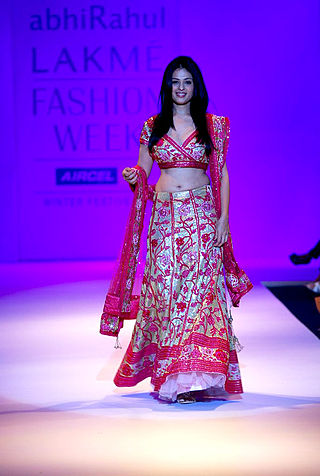
The lehenga, lehnga or langa or लेहंगा is a form of ankle-length skirt from the Indian subcontinent. Different patterns and styles of traditional embroidery are used to decorate lehenga. Gota patti embroidery is often used for festivals and weddings. The lehenga, also known as the ghagra, is a traditional Indian garment that became popular in the 16th century, mainly in India, Bangladesh and Pakistan. The lehenga became a favorite attire for Mughal women of all ages and classes due to its royal appeal and convenience The lehenga is sometimes worn as the lower portion of a gagra choli or langa voni. Ghagra in Hindi, was also used to refer to the half slip or petticoat, a skirt worn as an undergarment below the sari.

Ghagra choli is a type of ethnic clothing for women from the Indian Subcontinent, notably in the Indian states of Rajasthan, Gujarat, Madhya Pradesh, Uttar Pradesh, Bihar, Haryana, Punjab, Himachal Pradesh, Uttarakhand, Jammu and Kashmir, as well as in the Pakistani provinces of Punjab and Sindh. In Punjab, the lehenga is traditionally worn with a kurti. It is a combination of the gagra or lehenga and the choli (blouse), however in contemporary and modern usage lehenga choli is the more popular and widely accepted term by fashion designers, trend setters, and boutiques in South Asia, since ghagra is synonymous with the half-slip (petticoat) worn as an undergarment below the sari.

Trousers, slacks, or pants are an item of clothing worn from the waist to anywhere between the knees and the ankles, covering both legs separately. In the United Kingdom, the word pants generally means underwear and not trousers. Shorts are similar to trousers, but with legs that come down only to around the area of the knee, higher or lower depending on the style of the garment. To distinguish them from shorts, trousers may be called "long trousers" in certain contexts such as school uniform, where tailored shorts may be called "short trousers" in the UK.

Underwear, underclothing, or undergarments are items of clothing worn beneath outer clothes, usually in direct contact with the skin, although they may comprise more than a single layer. They serve to keep outer clothing from being soiled or damaged by bodily excretions, to lessen the friction of outerwear against the skin, to shape the body, and to provide concealment or support for parts of it. In cold weather, long underwear is sometimes worn to provide additional warmth. Special types of undergarments have religious significance. Some items of clothing are designed as undergarments, while others, such as T-shirts and certain types of shorts, are appropriate both as underwear and outerwear. If made of suitable material or textile, some underwear can serve as nightwear or swimwear, and some undergarments are intended for sexual attraction or visual appeal.

The thong is a garment generally used as either underwear or in some countries, as a swimsuit. It may also be worn for traditional ceremonies or competitions.

Wearing underwear as outerwear is a fashion trend popularized by celebrities, sports and media. It began as a practical and comfortable variation of clothing, such as the T-shirt and the sleeveless shirt, but later evolved into provocative, controversial fashion statements. 21st century versions include the display of thongs and bras in women's clothing, and the display of underpants under low-slung pants in men. Wearing underwear as outerwear has historical antecedents in the display of undergarments in the sixteenth and seventeenth centuries.

A high-rise or high-waisted garment is one designed to sit high on, or above, the wearer's hips, usually at least 8 centimetres (3 inches) higher than the navel. In western cultures, high-rise jeans were especially common in the 1970s, late 1980s through the late 1990s, derided as mom jeans in the 2000s, and popular again in the mid-to-late 2010s and continues to be popular into the present in competition with low-rise pants.
Cultural views on the midriff and navel vary significantly. In some cultures the navel is seen as sexually and culturally significant, and its exposure has been subject to a variety of cultural norms and taboos, based on concepts of modesty. The views, customs and fashions relating to the midriff and navel change from time to time, and such exposure has become more widely acceptable, as reflected in the designs of clothing.

A belly fetish is a partialism in which an individual is sexually attracted to the midriff or belly.



















